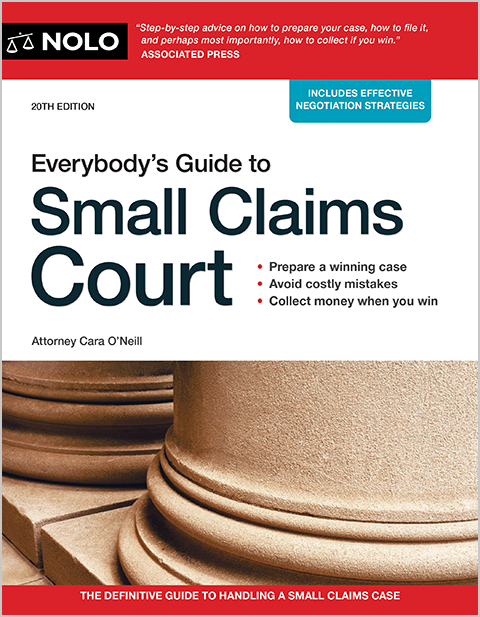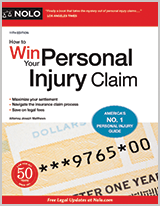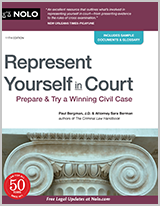Includes rules for all 50 states
Everybody's Guide to Small Claims Court
- Product Details
- assess your case’s value
- mediate an out-of-court settlement
- file and serve papers
- gather supporting evidence
- line up persuasive witnesses
- present a convincing case, and
- collect money when you win.
- About the Author
- Table of Contents
- Why Use Small Claims Court?
- Will Small Claims Work for You?
- How to Use This Book
- Stating Your Claim
- But Is My Case Any Good?
- Breach of Contract Cases
- Personal Injury and Property Damage Cases
- Workplace Discrimination
- Defective Product Cases
- Breach of Warranty Cases
- Professional Malpractice Cases
- Nuisance Cases
- Cutting Your Claim to Fit the Limit
- Calculating the Amount of Your Claim
- Equitable Relief When Money Can’t Solve the Problem)
- Statute of Limitations
- Calculating the Statute of Limitations
- What If the Statute of Limitations Has Run?
- Negotiation
- The Negotiation Process
- Mediation
- Formal Demand Letters
- Get Your Settlement in Writing (a Release)
- Last-Minute Agreements
- Married Couples
- Sole Proprietorships
- Business Partnerships
- Corporations
- Limited Liability Companies
- Nonprofits and Unincorporated Associations
- Motor Vehicle Claims
- Government Agencies
- Special Rules for Prisoners and Military Personnel
- Suits by Minors
- Class Actions (Group Lawsuits)
- Participation by Attorneys and Bill Collectors
- One Person
- Two or More People
- Individually Owned Businesses
- Partnerships
- Corporations and Limited Liability Companies (LLCs)
- Motor Vehicle Accident Cases
- How to Sue Minors
- How to Sue Government Agencies
- A Deceased Person’s Estate
- Out-of-State Defendants
- Defendants in Your State
- If You Are Sued in the Wrong Court
- How Much Does It Cost?
- Filing Your Lawsuit
- The Defendant’s Forms
- Jury Trials
- Your Court Date
- Who Must Be Served
- Where Can Papers Be Served?
- Serving an Individual
- Serving a Business
- How to Serve a Government Agency
- Time Limits for Serving a Claim
- Proof of Service—Letting the Court Know
- Serving a Defendant’s Claim
- Serving Subpoenas
- Costs of Service
- If You Aren’t Properly Served
- If You’re Sued in the Wrong Court
- If the Statute of Limitations Has Expired
- Try to Compromise
- Try to Mediate
- If You Have No Defense
- Paying in Installments
- If You, Not the Plaintiff, Were Wronged—File a Defendant’s Claim
- Transferring Your Case to a Higher Court
- Fight Back
- Using a Private Lawyer
- Consider Mediation—Again
- Be Prepared
- Getting to the Courthouse
- The Courtroom
- The Judge or Commissioner
- Your Courtroom Strategy
- Organize Your Testimony and Evidence
- What Makes a Good Witness
- How to Subpoena Witnesses
- How to Subpoena Police and Other Peace Officers
- How to Subpoena Documents
- Witness Testimony by Letter
- Judges as Witnesses
- Testimony by Telephone
- If the Defendant Is a No-Show
- If the Plaintiff Is a No-Show
- Your Day in Court
- Recovering Costs
- A Sample Contested Case
- Do You Have a Case?
- Prepare for Court
- Appearing in Court
- New Vehicles
- Used Vehicles From Dealers
- Used Vehicles From Private Parties
- Who Should Appear in Court?
- From the Plaintiff’s Point of View
- From the Debtor’s Point of View
- Who Can Sue Whom?
- Was There a Witness?
- Traffic Collision Reports
- Determining Fault
- Diagrams
- Photos
- Estimates
- Your Demand Letter
- Appearing in Court
- Security Deposit Cases
- Unpaid Rent and Former Tenants
- Former Tenants’ Defenses to Unpaid Rent
- Drug Dealing and Other Crimes
- The Obnoxious Landlord
- The Landlord’s Right of Entry and the Tenant’s Right of Privacy
- Discrimination
- Evictions for Nonpayment of Rent
- Clothing (Alteration and Cleaning)
- Dog-Related Cases
- Damage to Real Estate (Land and Buildings)
- Defamation
- Online Transactions
- Remember: You Didn’t Always Hate the Other Guy
- Organizing Your Case
- A Case Study—Proving a Contract Exists
- A Case Study—Personal Services Contract
- The Judgment
- Paying the Judgment
- Satisfaction of Judgment
- The Appeal
- The Timing of Collecting Your Money
- How to Collect
- Installment Payments
- Judgments Against Government Agencies
- Finding the Debtor’s Assets
- Levying on Wages, Bank Accounts, and Other Property
- Judgments From Auto Accidents
- Property Liens
- Collection Costs
- Renew Your Judgment
- Local Laws
- State Laws
- Case Law
- Sample Chapter
- You can present your case without paying a lawyer more than your claim is worth.
- Filing, organizing, and representing yourself in a small claims case is relatively easy. The complicated legal forms and language found in other courts are minimal. To start your lawsuit, you need only fill out a few lines on a simple form (for example, “Defendant owes me the sum of $4,000 because the 2014 Impala he sold me on January 1, 2024 in supposedly ‘excellent condition’ died less than a mile from the car lot”).
- You aren’t required to use legal jargon and can talk to the judge in plain English when you get to court.
- Small claims court doesn’t take long. The court clerk will set a trial date within two or three months after you file your claim. The hearing will likely take 15 minutes or less, and the judge will announce a decision immediately or mail it to you within a few days.
- Learn enough law to answer critical questions. What do you have to prove in your case? For instance, the evidence required will differ in personal injury claims and security deposit disputes. Do you have the evidence needed to win? If so, how much could you win?
- Understand how best to prepare and present your case. You’ll need to know the correct papers to file and how to serve them. You’ll also need to know other legal rules and the general process. For instance, will you be required to attend mediation? How many exhibit copies must you bring? How much time will you have to speak?
- Finally, and most importantly, will you be able to collect the money if you win? Unfortunately, winning plaintiffs who sue a “judgment- proof” defendant—someone without collectible funds or assets—recover nothing.
- Do you have a good case? Can you establish or prove everything the law requires (the “elements” of the action) to win your claim? (See Chapters 2 and 14–22.)
- How much is your claim worth? If the value is more than the small claims maximum, are you okay with waiving the excess and proceeding with small claims court? (See Chapter 4.)
- Have you made a reasonable effort to contact the other party and settle the case? (See Chapter 6.)
- Are you within the deadline (statute of limitations) by which you must file your suit? (See Chapter 5.)
- Who will you sue, and how must you identify this person or business on your court papers? In some cases, especially those involving companies and automobiles, this can be trickier than you might think. (See Chapter 8.)
- Which small claims court should you file your suit in? (See Chapter 9.)
- If your small claims court offers or encourages mediation, do you understand how it works and how best to use it? (See Chapter 6.)
- Can you make a convincing courtroom presentation? (See Chapter 15.)
- Assuming you win, is there a reasonable chance you can collect? (See Chapters 3 and 24.)
- Do you have legal grounds for a countersuit against the plaintiff? Put another way, does the plaintiff owe you money instead of the other way around? (See Chapters 10 and 12.)
- Do you have a partial or complete defense against the plaintiff’s claim? In other words, has the plaintiff filed a bogus lawsuit? (See Chapters 2 and 12.)
- Is the plaintiff’s money demand reasonable or excessive? (See Chapter 4.)
- Has the plaintiff brought the suit within the proper time limit? (See Chapter 5.)
- Has the plaintiff followed the correct procedures in bringing suit and delivering the court papers to you? (See Chapters 11 and 12.)
- If your small claims court offers or encourages mediation, do you understand how it works and how to use it? (See Chapter 6.)
- Have you made a reasonable effort to contact the plaintiff to arrive at a settlement? (See Chapters 6 and 12.)
- Assuming you’ll fight the case in court, you’ll typically need proof that your version of events is correct. Do you have the evidence and witnesses to accomplish this? (See Chapters 13–15.)
- Are you prepared to present your side of the case convincingly in court? (See Chapter 15.)
You don’t need a lawyer to succeed in small claims court if you know how to present your own case. Everybody’s Guide to Small Claims Court provides the information, tips, and strategies needed to sue someone successfully or put up a winning defense. Find out how to:
You’ll find instructions for following the latest small claims court procedures and detailed explanations of the legal requirements for many common lawsuits.
“Step-by-step advice on how to prepare your case, how to file it, and perhaps most importantly, how to collect if you win.”—Associated Press
“Useful advice…for anyone trying to get money back.”—Money Magazine
Your Small Claims Court Companion
1. Basics of Small Claims Court
2. Do You Have a Good Case?
3. Can You Collect Your Money If You Win?
4. How Much Can You Sue For?
5. When Should You Sue?
6. Settling Your Dispute
7. Who Can Sue?
8. Suing Different Kinds of Defendants
9. Where Can You Sue?
10. Filing Fees, Court Papers, and Court Dates
11. Serving Your Papers
12. The Defendant’s Options
13. Getting Ready for Court
14. Witnesses
15. Your Day in Court
16. Motor Vehicle Repair Cases
17. Motor Vehicle Purchase Cases
18. Bad Debts: Initiating and Defending Cases
19. Vehicle Accident Cases
20. Landlord-Tenant Cases
21. Miscellaneous Cases
22. Disputes Between Small Businesses
23. Judgment and Appeal
24. Collecting Your Money
25. Legal Research
Appendix:
Legal Jargon for Small Claims Court
Index
Chapter 1:
The Basics of Small Claims Court
Why Use Small Claims Court?
Small claims court aims to hear lawsuits involving modest amounts of money without long delays and formal rules of evidence. Lawyers are prohibited in some states, including Michigan and California, but are allowed in most. However, the limited dollar amounts involved usually make it economically unwise to hire a lawyer, and disputes are typically presented directly by the people involved.
CAUTION
Check your state’s jurisdictional amount before you file. The “jurisdictional” amount a small claims judge can award is limited and changes periodically. You’ll want to ensure the jurisdictional amount is high enough to potentially reimburse you fully before pursuing a case in small claims court. If your case is worth substantially more than you can recover, consider consulting a litigation lawyer about your options.
Several significant advantages of small claims court include the following:
Will Small Claims Work for You?
Before deciding whether small claims court is the right place to bring your case, you will want to answer a fundamental question: Will it be worth the effort? Even in small claims court, you’ll spend a good deal of time preparing. And if you’re the anxious type, the process could cause a few sleepless nights.
Getting a good picture of how small claims court works will help you determine whether your dispute is worth bringing. The best place to start? Learn who can sue, where, and for how much. If success looks within reach, move on to more critical, time-intensive analysis. For instance, you’ll want to do the following:
But you don’t need to do all the work on your own. Both plaintiffs and defendants can use this guide’s step-by-step instructions to bring or defend a small claims case successfully.
The first several chapters will help you decide whether you have a case worth pursuing. These chapters cover the basics, not the grand strategies that will baffle and confound the opposition. That comes later (well, sort of—keep in mind that any particular approach is only as good as the facts of the case).
You’ll learn about mundane yet critical tasks like locating the person you want to sue, suing in the proper court, filling out the necessary forms, and delivering the documents to the person you’re suing.
Below are checklists of issues plaintiffs and defendants should consider at this initial stage. The following chapters address each area in more detail and include targeted advice for both sides.
| Initial Stage Questions for a Plaintiff |
|---|
| Initial Stage Questions for a Defendant |
|---|
TIP
Defendants might want to file a lawsuit against you. In addition to defending themselves, some defendants take the opportunity to file a case against the plaintiff. (See Chapters 10 and 12.) This situation could occur if a defendant lost money due to the same events the plaintiff is suing over, and the defendant will win if the judge finds the plaintiff legally responsible for the loss. Defendants’ claims are most common when both parties are negligent, such as in a car accident. In most states, the question becomes each driver’s percentage of fault.
Also, suppose a defendant’s claim is for more than the small claims court maxi- mum. In that case, the defendant could ask the court to transfer the case to a higher court that is more complicated to navigate. (See Chapter 10.)
How to Use This Book
After completing this overview chapter, Chapters 2 and 3 will help you determine whether you have a viable suit and can collect from the defendant if you win. If you answer “no” to either question, consider settling your dispute without going to court or dropping the idea of a lawsuit. You’ll find help in Chapter 6.
Chapters 4 through 9 walk you through the procedural details. Small claims court should be accessible, but it still has rules you must follow.
Chapters 10 and 11 discuss the paperwork: How do you fill out forms and deliver them to the defendant? Chapter 12 explains what a defendant should do after being sued. Chapters 13 through 15 prepare you for your day in court. Chapters 23 and 24 address how the judge issues a ruling, how to collect your money if you’re successful, and how to appeal an unexpectedly awful day in court.
In Chapters 16 through 22, we discuss strategies you can use to handle common cases. Even if your situation doesn’t fit neatly into one of the categories, read this material. By picking up a few hints here and a little information there, you should be able to piece together a good action plan. For example, you can apply many suggestions on handling motor vehicle repair disputes to cases involving major appliances such as a television, dishwasher, or dryer. However, these days, it’s often cheaper to buy new.
In the Appendix, you’ll find a glossary of legal jargon you might come across in small claims cases and courts. Fortunately, not much of it exists, but a few terms might be new. If you can’t find what you need, check Nolo’s Free Dictionary of Law Terms and Legal Definitions at www.nolo.com/dictionary.
Because state law establishes small claims procedures, rules differ from state to state, including the maximum amount you can sue for, who can sue, and the what, where, and when of filing papers. States even call small claims court (or its equivalent) different things, like “justice,” “district,” “municipal,” “city,” “county,” and “magistrates” court.
Also, plaintiffs and defendants will want to check state small claims court websites early. You’ll find valuable information about your state’s small claims process. Also, check the local small claims court clerk’s office for local rules (local court rules also vary). The bottom line is that understanding details is important, and you must be able to manage state and local small claims court rules comfortably.
Even so, preparing and presenting a legal case is remarkably similar everywhere, and the information in this book will help.
We hope you enjoyed this sample. The complete book is available for sale here at Nolo.com.



